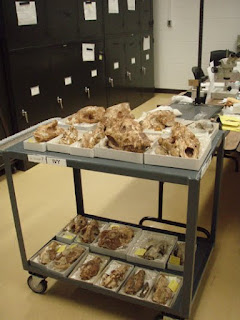0900. I hopped on the "C" Train going south-bound on Central Park West and got to the museum before my start time of 0930. With some time to kill, I headed straight for the mammal exhibits. I figured by visiting a few exhibits every morning before work I could get everything in without losing valuable research time.
 [exhibit: an impressive display of a growth series of the dinosaur Protoceratops discovered in Mongolia by the Central Asiatic Expeditions in the 1920s]
[exhibit: an impressive display of a growth series of the dinosaur Protoceratops discovered in Mongolia by the Central Asiatic Expeditions in the 1920s]0930-1240. I continued to photograph the specimens of borophagine dogs, and after that was done I proceeded to the cabinets (4 of them) holding hesperocyonine dogs. Hesperocyoninae is a sub-family of dogs that was ancestral to borophagines and the modern canines we know as dogs, wolves, foxes, jackals, and their relatives. Most of the hesperocyonines I photographed are Oligocene in age, with a few ranging into the early Miocene.
A peek outside during lunchtime revealed overcast skies with temperature around 3-5 degrees C (37-40 F). I am not to sad to be indoors...just saving outdoor playing time for when I am in California!
The afternoon began with an overview of the Chinese hyenas in the American Museum collection; several species of the Hyaenidae were jackal-like, wolf-like, and mongoose-like in their appearance, as discovered by previous researchers. For this reason, hyaenids are interesting parallels to study if one were to understand the ecological evolution of true dogs.
I photographed 28 specimens in the afternoon, mostly hyaenids from the famous Baode locality in Shanxi Province, China. After all the photographing is done, it was 1700 and I still had some time to kill before I have to leave the museum. So, I went up to the 10th floor of the Frick Building (the building with all the mammal fossils) and chatted it up with Dr. Ni Xijun, having some great green tea in the process.
 [exhibit: the AMNH's diorama on the living spotted hyena Crocuta crocuta is larger than ours in the LACM; however, both are equally unflattering by showing the hyena as a scavenger. Spotted hyenas are specialized hunters that are smart enough to scavenge (they are not obligate scavengers like the vultures)]
[exhibit: the AMNH's diorama on the living spotted hyena Crocuta crocuta is larger than ours in the LACM; however, both are equally unflattering by showing the hyena as a scavenger. Spotted hyenas are specialized hunters that are smart enough to scavenge (they are not obligate scavengers like the vultures)]Writing up the day's work in my fieldbook (yes I treat museum visits much like fieldwork; it's the best way to get a lot done in a limited amount of time), I realized that my luggage still has not arrived. Since I am done with photographing, I would begin the next phase in my data collection - examining teeth under the microscope for microstructure differences. This next task will take me at least a whole day, so hopefully the rest of my equipment will arrive by beginning of Day 4 in order for me to stay on track to clean and mold a sample of teeth to make casts for examination of surface scratches as an indication of the fossil dogs' and hyenas' diet.
 [my hands are shaking with excitement...it is the holotype specimen of Tunggurictis spocki, an early hyena found in the Tunggur Formation of central Inner Mongolia discovered by the Central Asiatic Expedition]
[my hands are shaking with excitement...it is the holotype specimen of Tunggurictis spocki, an early hyena found in the Tunggur Formation of central Inner Mongolia discovered by the Central Asiatic Expedition]Tired, hopeful, but a tiny bit frustrated at Delta Airline for my delayed bag,
~Jack





3 comments:
The two P's for the day will be:
1) Seriously wowed by the Protoceratops skull display
2) Excited about LACM's Palaeoparadoxia, and a sneak-peek in general
3) And for T, your Tunggurictis giddiness just wore off on me.
Cheers!
Ok that should be the quote of the day, what you just wrote :)
Ha! Really? So...
Why isn't it? ;-P
Post a Comment